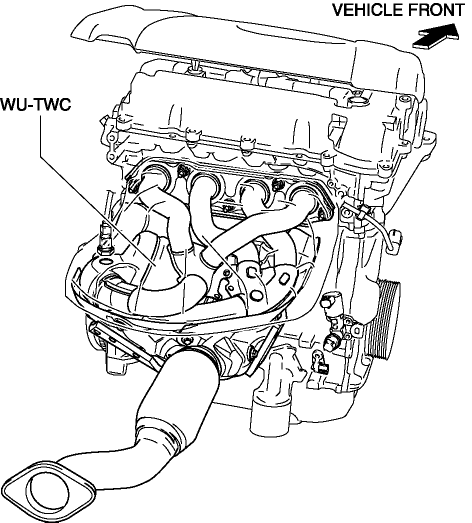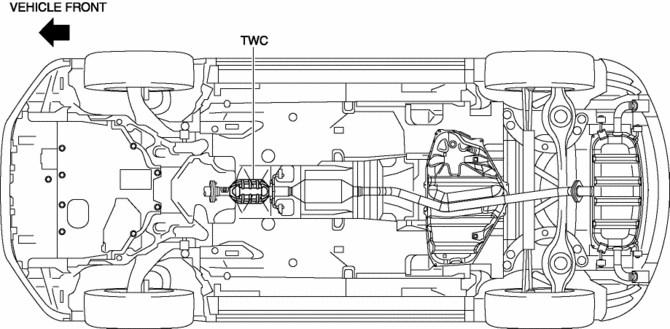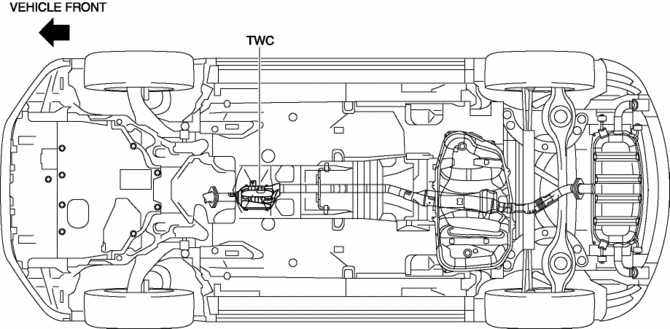Mazda CX-5 Service & Repair Manual: Catalytic Converter
Purpose, Function
-
Purifies contaminants in the exhaust gas by utilizing the chemical reactions of the three-way catalytic converter.
-
A WU-TWC and a TWC have been adopted.
-
The three-way catalyst is integrated with the exhaust manifold.
-
Because the catalyst receives the high temperature exhaust gas just after the gas is exhausted, it activates quickly and achieves an improved purification performance.
-
A single-nano catalyst has been adopted in which the purification performance can be maintained using less precious metal materials than conventional catalysts.
-
WU-TWC
-
TWC
Construction
WU-TWC
-
The WU-TWC is installed to the rear of the engine.

-
The WU-TWC is integrated with the exhaust manifold.
TWC
-
The TWC is installed to the rear of the WU-TWC.
2WD

AWD

-
A single-nano catalyst has been adopted for the under-floor three-way catalyst. With a conventional three-way catalyst, the precious metals move and agglutinate to each other by the heat of the exhaust gas because they are structured such that they adhere on catalyst material. Therefore, it was necessary to use a large amount of precious metal because it is estimated that the purification performance lowers due to the decrease in the surface area of the precious metals. The single-nano catalyst is structured such that it embeds small precious metal particles into the catalyst material. Because the precious metal particles do not agglutinate on the surface of the three-way catalyst, it can maintain superior purification performance using less precious metal than the conventional system.

Operation
-
Contaminants in the exhaust gas (HC, CO, NOx) are purified by oxidization and deoxidization while they are passing through the catalytic converter.
-
Oxidization process
-
Noxious hydrocarbon (HC) and carbon monoxide (CO) are bound with oxygen and converted to non-noxious carbon dioxide and water.
O2+HC+CO>CO2+H2O
-
Deoxidization process
-
Noxious nitrogen oxide (NOx) is converted to non-noxious nitrogen and oxygen. A part of the oxygen generated in this process is used in the oxidization process.
NOx>N2+O2
 Canister Vent (Cv) Solenoid Valve
Canister Vent (Cv) Solenoid Valve
U.S.A. And CANADA
Purpose, function
Seals the atmosphere side of the charcoal canister during EVAP leak check
monitoring.
Construction
Included in the charcoal canister.
...
 Catch Tank Inspection
Catch Tank Inspection
1. Remove the catch tank..
2. Plug the purge solenoid valve side into the catch tank.
3. Inspect for air leakage when blowing air using your mouth into the charcoal
canister side.
If ...
Other materials:
Passenger Compartment Temperature Sensor Removal/Installation [Full Auto Air
Conditioner]
1. Disconnect the negative battery cable..
2. Remove the following parts:
a. Front scuff plate (driver-side).
b. Front side trim (driver-side).
c. Switch panel.
d. Decoration panel.
e. Shift lever knob (MTX).
f. Front console box.
g. Shift panel.
h. Upper panel.
i. Rear console. ...
Adaptive Front Lighting System (Afs) Control Module Removal/Installation
NOTE:
The AFS control module prior to replacement stores the vehicle specification
information.
A new AFS control module does not store any vehicle specification information.
When the ignition is switched ON after the AFS control module is replaced,
the AFS control modu ...
Control System [Full Auto Air Conditioner]
Outline
Refrigerant pressure sensor adopted in which refrigerant pressure is changed
into a linear electric signal and precise information is transmitted.
MS-CAN for communication between the instrument cluster and climate control
unit adopted.
Climate control un ...
